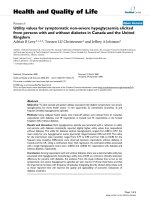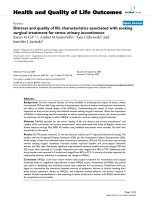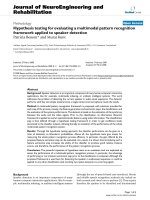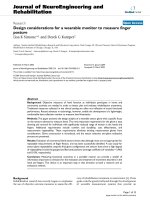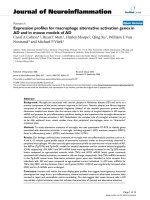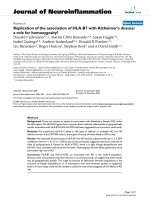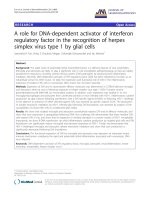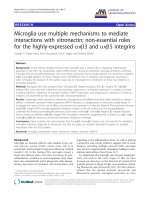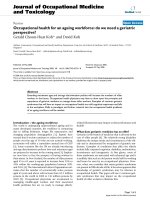Báo cáo hóa học: " Frequency-domain equalization for OFDMA-based multiuser MIMO systems with improper modulation schemes" docx
Bạn đang xem bản rút gọn của tài liệu. Xem và tải ngay bản đầy đủ của tài liệu tại đây (431.59 KB, 8 trang )
RESEARCH Open Access
Frequency-domain equalization for OFDMA-based
multiuser MIMO systems with improper
modulation schemes
Pei Xiao
1*
, Zihuai Lin
2,5
, Anthony Fagan
3
, Colin Cowan
4
, Branka Vucetic
2
and Yi Wu
5
Abstract
In this paper, we propose a novel transceiver structure for orthogonal frequency division multiple access-based
uplink multiuser multiple-input multiple-output systems. The numerical results show that the proposed frequency-
domain equalization schemes significantly outperform conventional linear minimum mean square error-based
equalizers in terms of bit error rate performance with moderate increase in computational complexity.
Keywords: OFDMA, multiple-input multiple-output (MIMO), frequency-domain equalization
1 Introduction
Multiple-input multiple-output (MIMO) techniques in
combination with orthogonal frequency division multiple
access (OFDMA) have been commonly used by most of
the 4G air-interfaces, e.g., WiMAX, long-term evolution,
IEEE 802.20, Wireless broadband, etc. In the IEEE
802.16e mobile WiMAX standard, OFDMA has been
adopted for both downlink and uplink transmission [1,2].
In 3GPP LTE, single carrier (SC) frequency division mul-
tiple access (FDMA) is used for uplink transmission,
whereas the OFDMA signaling format is exploited for
downlink transmission [3]. There are also some proposals
on using OFDMA for uplink transmission in the LTE
advanced (LTE-A) sta ndard, in which both S C-FDMA
and OFDMA can be considered for uplink transmission.
This paper investigates receiver algorithms for the
uplink of OFDMA-based multi-user MIMO systems. Fre-
quency-domain equalization (FDE) is commonly used for
OFDMA. This includes frequency domain linear equaliza-
tion (FD-LE) [4], decision feedback equalization (DFE)
[5,6], and the more recent turbo equalization (TE) [7,8].
FD-LE is analogous to time-domain LE. A zero-forcing
(ZF) LE [9] eliminates intersymbol interference (ISI) com-
pletely but introduces degradation in the system perfor-
manc e due to noise enhancement. Superior per formance
can be achieved by using the minimum mean square error
(MMSE) criterion [9], which accounts for additive noise in
addition to ISI. In OFDMA, a DFE results in better perfor-
mance than a LE due to its ability to remove past echo ISI.
However, a DFE is prone to error propagation when incor-
rect decisions are fed back. Consequently, it suffers from a
performance loss for long error bursts. The principle that
TE employs to improve performance is to add complexity
at the receiver through an iterative process, in which feed-
back information obtained from the decoder is incorpo-
rated into the equalizer at the next iteration. The iterative
processing allows for reduction of ISI, mu ltistream inter-
ference, and noise by exchanging extrinsic information
between the equalizer and the decoder [7,8].
The second-order properties of a complex random pro-
cess are completely characterized by its autocorrelation
function as well as the pseudo-autocorrelation function
[10]. Most existing studies on receiver algorithms only
exploit the information contained in the autocorrelation
function of the observed signal. The pseudo-autocorrela-
tion function is usually not considered and is implicitly
assumed to be zero. While this is the optimal strategy
when dealing with proper complex random processes
[11], it turns out to be sub-optimal in situations where
the transmitted signals and/or interference are improper
complex random processes, for which the pseudo-auto-
correlation function is non-vanishing, and the perfor-
mance of a linear receiver can be improved by the use of
widely linear processing (WLP) [12]. Such a scenario
* Correspondence:
1
Centre for Communication Systems Research, University of Surrey, Guildford,
Surrey, GU2 7XH, UK
Full list of author information is available at the end of the article
Xiao et al. EURASIP Journal on Advances in Signal Processing 2011, 2011:73
/>© 2011 Xiao et al; licensee Springer. This is an Open Access article distributed under the terms of the Creative Commons Attribution
License ( which permits unrestricted use, distribution, and reproduction in any medium,
provided the original work is properl y cited.
arises when transmitting symbols with improper modula-
tion formats (e.g., ASK and OQPSK) over complex chan-
nels. It was shown in Schreier et al. [10] that the
performance gain of WLP compared to conventional
processing in terms of mean square error can be as large
as a factor of 2. MIMO transceiver design was considered
in Mattera et al. [13], Sterle [14], where it was shown that
when channel information is available both at the trans-
mitter and receiver, joint design of the precoder and
decoder using WLP yields considerable performance
gains at the expense of a limited increase in the computa-
tional complexity, compared to the conventional linear
transceiver in the scenario where real-valued symbols are
transmitted over complex channels. By using the same
principle, a real-valued MMSE (RV-MMSE) beamformer
was dev eloped in Chen et al. [15] for a binary phase s hift
keying (BPSK)-modulated system and was shown to offer
significant enhancements over the standard complex-
valued MMSE (CV-MMSE) design in terms of bit error
rate performance and the number of supported users.
In this paper, we show that the conventional frequency-
domain linear equalizer is suboptimal for improper sig-
nals and that performance ca n be greatly improved by
applying widely linear processing and utilizing complete
second-order statistics of improper signals.
Notations: we use upper bold-face letters to represent
matrices and vectors. The (n, k)th element of a matrix
A is represented by [A]
n,k
,thenth element of a vector b
is denoted by [b]
n
,andthenth column of a matrix A is
represented by (A)
n
.Superscripts
(
·
)
H
,
(
·
)
T
and (·)*
denote the Hermitian transpose, transpose, and conju-
gate, respectively. E[·] denotes expectation (statistical
averaging).
2 System model
The cellular multiple access system under study has n
R
receive antennas at the BS and a single transmit antenna
at the i th user terminal, i =1,2, ,K
T
,whereK
T
is the
total number of users in the system. We consider the
multi-user MIMO case with K (K ≤ K
T
) users being served
at each time slot and K = n
R
. The system model for an
OFDMA-based MIMO transmitter and receiver is shown
in Figures 1 and 2, respectively. On the transmitter side,
the user data block containing N symbols first goes
through a subcarrier mapping block. These symbols are
then mapped to M (M >N) orthogonal subcarriers fol-
lowed by an M-point inverse fast fourier transform (IFFT)
to convert to a time-domain complex signal sequence.
There are two approaches to mapping subcarriers
among mobile stations (MSs) [3] : localized mapping and
distributed mapping. The former is usually referred to
as localized FDMA transmission, while the latter is
usually called distributed FDMA transmission scheme.
With the localized FDMA transmission scheme, e ach
user’ s data are transmitted by consecutive subcarriers,
whereas with the distributed FDMA transmission
scheme, the user’s data are placed in subcarriers that are
distributed across the OFDM symbol [3]. Because of the
spreading of the information symbols across the entire
signal band, the distributed FDMA scheme is more
robust against frequency-selective fading and can thus
achieve better frequency diversity gain. For localized
FDMA transmission, in the presence of a frequency-
selective fading chann el, multiuser diversity and fre-
quency diversity can also be achieved if each user is
assigned to subcarriers with favorable transmission char-
acteristics when the channel is known at the transmitter.
In this work, we only consider localized FDMA trans-
mission. A cyclic prefix (CP) is inserted into the signal
sequence before it is passed to the radio frequency (RF)
module. On the receiver side, the opposite operating
procedures are performed after the noisy signals are
received by the receive antennas. A MIMO frequency-
domain equalizer (FDE) is applied to the frequency-
domain signals after subcarrier demapping as shown in
Figure 2. For si mplicity, we employ a linear MMSE
receiver, which provides a good tradeoff between the
noise enhancement and the multiple stream interference
mitigation [16].
In the following, we let
D
F
M
=
I
K
⊗
F
M
and denote by
F
M
the M × M Fourier matrix with the element
[F
M
]
m,k
= exp(−j
2π
M
(m −1)(k −1)
)
where k, m Î {1, ,
M}arethesamplenumberandthesubcarriernumber,
respectively. Here, ⊗ is the Kronecker product, and I
K
is the K × K identity matrix. We denote by
D
−1
F
M
= I
K
⊗ F
−
1
M
the KM × KM matrix where
F
−
1
M
is the
M × M inverse Fourier matrix with element
[F
−1
M
]
m,k
=
1
M
exp(j
2π
M
(m −1)(k −1)
)
. F urthermore, we
let F
n
represent the subcarrier mapping matrix of size
M × N.Then,
F
−
1
n
is the subcarrier demapping matrix
of size N × M.
The received signal after the RF module and CP
removal becomes
˜
r =
˜
HD
−1
F
M
(I
K
⊗ F
n
)x + ˜
w
,where
x =[x
T
1
, , x
T
K
]
T
∈ C
KN×
1
is the data sequence of all K
users, and x
i
Î ℂ
N ×1
, i Î {1, , K}, is the transmitted
user data block for the ith user;
˜w
∈ C
Mn
R
×
1
is a circu-
larly symmetric complex Gaussian noise vector with
zero mean and covariance matrix
N
0
I ∈ R
Mn
R
×Mn
R
, i.e.,
˜
H
;
˜
H
is the n
R
M × KM channel matrix.
The signal after performing the FFT operation, sub-
carrier demapping, and employing a MIMO FDE is
given by
z = G
H
(I
K
⊗ F
−1
n
)D
F
M
˜
r = G
H
(I
K
⊗ F
−1
n
)D
F
M
(
˜
HD
−1
F
M
(I
K
⊗ F
n
)x + ˜w
)
= G
H
(
Hx + w
)
= G
H
(
HPs + w
)
= G
H
r,
(1)
Xiao et al. EURASIP Journal on Advances in Signal Processing 2011, 2011:73
/>Page 2 of 8
where
H =(I
K
⊗ F
−1
n
)D
F
M
˜
HD
−1
F
M
(I
K
⊗ F
n
) ∈ C
KN×KN
,
is the channel matrix in the frequency domain and r =
HPs + w; G is the KN × KN equalization matrix;
w
∈ C
n
R
N×
1
is a circularly symmetric complex Gaussian
noise vector with zero mean and covariance matrix
N
0
I ∈ R
n
R
N×n
R
N
,i.e.,
w ∼ C
N (
0, N
0
I
)
.Thevectorx can
be expressed as x = Ps,where
s =[s
T
1
···s
T
K
]
T
and s
i
Î
ℂ
N×1
, i Î {1, 2, , K}, is the user data block for the ith
user, and
E[s
i
s
H
i
]=I
N
. The power loading matrix P Î
ℝ
KN × KN
is a block diagonal matrix with its ith sub-matrix
expressed as
P
i
=diag
√
p
i,1
,
√
p
i,2
, ,
√
p
i,N
∈ R
N×
N
and p
i,n
(i Î {1, 2, , K}) is the transmitted power for the
ith user at the nth subcarrier; s Î ℂ
KN×1
represents the
trans mitted data sy mbol vector from different users with
E
[
ss
H
]
= I
KN
.
When proper modulation schemes are employed, the
conventional equalizer G can be derived from the cost
function
e =E
[
z − s
2
]
=E
[
G
H
r −s
2
]
. Minimizing
this cost function leads to the optimal solution
G = C
−1
rr
C
rs
=(HPP
H
H
H
+ N
0
I)
−1
HP
,
(2)
where
C
rr
=E
[
rr
H
]
= HPP
H
H
H
+ N
0
I
is the autocorre-
lation matrix of the observation vector r;
C
rs
=E
[
rs
H
]
= H
P
is the cross-correlation matrix between
the observation vector r and the symbol vector s.
Note that the aforementioned FDE is a joint equaliza-
tion algorithm, i.e., the transmitted symbols from differ-
ent users are jointly equalized. To achieve spatial
multiplexing gain, symbols from different users are
assigned to the same subcarriers in the studied
OFDMA-based multiuser MIMO system. Due to co-
channel interference (causing the channel matrix H to
be non-diagonal), we need to perform joint equalization
for the transmitted symbols from different users.
3 The proposed frequency-domain receiver
algorithm
In the p revious section, we presented the conventional
linear MMSE solution for the uplink of OFDMA-based
multiuser MIMO systems. It is designed based on the
autocorrelation matrix C
rr
and the cross-correlation
matrix C
rs
. It is only optimal for systems with proper
modulation, such as M-QAM and M-PSK, for which the
pseudo-autocorrelation
˜
C
rr
=E
[
rr
T
]
and the pseudo-
cross-correlation
˜
C
∗
r
s
=E[r
∗
s
H
]
are zero when M >2.
However, for improper modulation schemes, such as M-
ary ASK and OQPSK (for which both t he pseudo-auto-
correlation and the pseudo-cross-correlation are non-
zero), the conventional solution becomes suboptimal
because
˜
C
rr
and
˜
C
*
r
s
are not taken into consideration in
the receiver design. In order to utilize
˜
C
rr
and
˜
C
*
r
s
,we
need to apply widely linear processing [10,12], the prin-
ciple of which is not only to process r,butalsoits
{x
1
n
}
✲
Subcarr.
Mapping
✲
M point
IFFT
✲
Add CP
✲
RF
∇
{x
K
n
}
✲
Subcarr.
Mapping
✲
M point
IFFT
✲
Add CP
✲
RF
.
.
.
∇
Figure 1 OFDMA-based MIMO transmitter.
{z
1
n
}
{z
K
n
}
∇
∇
✲
RF
✲
Remove
CP
✲
˜
r
(1)
˜
r
(K)
M point
FFT
✲
Subcarr.
DeMap.
✲ ✲
✲
RF
.
.
.
✲
Remove
CP
✲
M point
FFT
✲
Subcarr.
DeMap.
✲
MIMO
EQZ
✲
Figure 2 OFDMA-based MIMO receiver.
Xiao et al. EURASIP Journal on Advances in Signal Processing 2011, 2011:73
/>Page 3 of 8
conjugated version r* in order to derive the filter output,
i.e.,
z = G
0
r + G
1
r
∗
=
H
y,
(3)
where
=
[
G
0
G
1
]
H
and
y
=[rr
∗
]
T
.Itisworth
noticing that the conventional linear MMSE receiver is
a special case of the one expressed by (3), when
G
0
= G
H
and G
1
= 0.
To derive the improved FDE, we re-define the detec-
tion error as
ε =
H
y
−
s
. According to the orthogonal-
ity principle [17], the mean-square value of the
estimation error ε is minimum if a nd only if it is ortho-
gonal to the observation vector y, i.e.,
E[yε
H
]=E[y
(
H
y −s
)
H
]=0
,
leading to the solution
n
= C
−1
yy
C
y
s
, where
C
yy
=E{yy
H
} =E
r
r
∗
r
H
r
T
=
C
rr
˜
C
rr
˜
C
*
rr
C
*
rr
,
(4)
and
C
rr
=E{rr
H
} =E{(HPs + w)(s
H
P
H
H
H
+ w
H
)} = HP E[ss
H
]P
H
H
H
+ N
0
I = HPP
H
H
H
+ N
0
I
,
˜
C
rr
=E{rr
T
} =E{(HPs + w)(s
T
P
T
H
T
+ w
T
)} = HP E[ss
T
]P
T
H
T
= HPP
T
H
T
,
C
ys
=E{ys
H
} =E
r
r
*
s
H
=E
rs
H
r
∗
s
H
=
C
rs
˜
C
*
rs
=
⎡
⎣
HP E
ss
H
H
*
P E
s
∗
s
H
⎤
⎦
=
HP
H
*
P
.
(5)
Based on the above derivations, we ca n form the opti-
mal solution for Ψ as
= C
−1
yy
C
ys
=
HPP
H
H
H
+ N
0
IHPP
T
H
T
H
∗
P
∗
P
H
H
H
H
∗
P
∗
P
T
H
T
+ N
0
I
−
1
HP
H
∗
P
.
(6)
For the proposed FDE, the augmented autocorrelation
matrix C
yy
and cross-correlation matrix C
ys
expressed
in (5), which give a com plete second-order description
of the received signal, are used to derive the filter coeffi-
cient matrix Ψ. On the other hand, for the conventional
linear MMSE algorithm, the coefficient matrix G is cal-
culated using only the autocorrelation of the observation
C
rr
and the cross-correlation C
rs
. The pseudo-autocor-
relation
˜
C
rr
and pseudo-cross-correlation
˜
C
*
r
s
are impli-
citly assumed to be zero, leading to sub-optimal
solutions.
For proper signals like QAM and PSK, the improved
FDE converges to the conventional FDE since
E
[
ss
T
]
= 0
, leading to
˜
C
rr
=E{rr
T
} =
0
and
˜
C
∗
rs
=E{r
∗
s
H
} =
0
. Therefore,
˜
C
rr
= 0
and
C
ys
=
HP
0
in
Eq. (5). The optimal solution of Ψ can be simplified to
= C
−1
yy
C
ys
=
C
rr
˜
C
rr
˜
C
∗
rr
C
∗
rr
−1
HP
0
=
C
rr
0
0C
∗
rr
−1
HP
0
=
C
−1
rr
0
0 (C
∗
rr
)
−1
HP
0
= C
−1
rr
HP =(HPP
H
H
H
+ N
0
I)
−1
HP,
which is exactly the same as Eq. (2) for the conven-
tional FDE.
The improved FDE has higher computational com-
plexity than the conventional FDE. The difference in
complexity lies in the computation of the matrix G for
the conventional equalizer and the computation of Ψ
for the improved equalizer as indicated in Table 1,
where we show the number of complex multiplication
(×), division (÷), addition (+), and subtraction (-) opera-
tions to calculate G and Ψ, respectively. In the complex-
ity calculation, we use the fact that for a L × L matrix,
its matrix inversion involves 2L
2
divisions, 2L
3
multipli-
cations, and 2L
3
subtractions. It should also be noted
tha t the complexity increase by the improved sche me is
compensated for the significant performance improve-
ment. Furthermore, this issue becomes less critical in
slow-fading channels for which the equalizer matrices
do not need to be updated frequently.
In Figure 3, we show the number of flops required to
compute the matrix G (for the conventional FDE) and
the matrix Ψ (for the improved FDE) as a function of
thedatablocksizeN for a 2-user case. One flop is
counted as one real operation, which can be addition,
subtraction, multiplication, or division [18]. A complex
division requires 6 real multiplications, 3 real additions /
subtractions, and 2 real divisions. A complex multiplica-
tion requires 4 real multiplications and 2 real additions.
It is evident from Figure 3 that the additional operations
required by the improved FDE is moderate when the
block size is small, e.g., N < 10, and increases signifi-
cantly when the block size increases. For example, the
number of flops required by the improved FDE is 4.5
times that required by the conventional FDE when N =
12. Therefore, for efficient implementation, it is neces-
sary to break the received data into bloc ks of moderate
sizes before the equalization is applied.
4 The proposed iterative receiver algorithm
In this section, we derive an iterative FDE algorithm by
applying WLP and exploiting the complete second-order
statistics of the improper signals. Recall that the
received signal after CP removal, FFT and subcarrier
demapping can be expressed as
r = HPs + w
,
(7)
where the symbol vector
s =
s
1
s
n
−1
s
n
s
n
+1
S
NK
T
.Letus
assume that symbol s
n
is to be decoded. By using the
iterative interference cancelation technique [8,19,20], the
received vector can be expressed as
r
n
= r − HP
¯
s
n
= HP
[
s −
¯
s
n
]
+ w ∈ C
NK×1
,
(8)
Xiao et al. EURASIP Journal on Advances in Signal Processing 2011, 2011:73
/>Page 4 of 8
where r
n
is the interference canceled version of r, and
¯
s
n
=
¯
s
1
¯
s
n−1
0
¯
s
n+1
¯
s
NK
T
,
(9)
which contains the soft estimate of the interfering
symbols from the previous iteration. Note that (8) repre-
sents a decision-directed iterative scheme, where the
detection procedure at the pth iteration uses the symbol
estimates from the (p - 1)th iteration. The performance
is improved in an iterative manner due to the fact that
the symbols are more accurately estimated (leading to
better interference cancelation) as the iterative proce-
dure goes on. For simplicity, the iteration index is
omitted, whenever no ambiguity arises.
In order to further suppress the residual interference
in r
n
, an instantaneous linear filter is applied to r
n
,to
obtain
z
n
= g
H
n
r
n
, where the filter coefficient vector g
n
Î
ℂ
NK×1
is chosen by minimizing
e
n
=E{| w
H
n
r
n
− s
n
|
2
}
,
under the MMSE criterion. It can be derived as
g
n
=[HPV
n
P
H
H
H
+ N
0
I]
−1
(HP)
n
,
(10)
where (HP)
n
is the nth column of the matrix HP. The
matrix V
n
Î ℝ
NK×1
is formed as
V
n
=diag{var(s
1
) var(s
n−1
) σ
2
s
var(s
n+1
) var(s
NK
)]}
,
(11)
where
σ
2
s
=E[| s
j
|
2
]
,and
var(s
j
)=E[| s
j
−
¯
s
j
|
2
]
.Referto
Wautelet et al. [19], Wang and Li [20], and Tuchler et al.
[8] for a detailed description of this conventional iterative
algorithm.
The conventional scheme suffers from the problem of
error propagation caused by incorrect decisions. As will
become evident in Section 5, the error propagation effect
can be reduced and the system performance can be
improved if we not only process r
n
but also its conjugated
version
r
∗
n
in order to derive the filter output, i.e.,
z
n
= a
n
r
n
+ b
n
r
∗
n
=
H
n
y
n
,where
n
=
[
a
n
b
n
]
H
and
y
n
=[r
T
n
(r
∗
n
)
T
]
T
. The filter Ψ
n
can be derived by minimiz-
ing the MSE E{| e
n
|
2
}, where
e
n
= z
n
− s
n
=
H
n
y
n
− s
n
.
According to the orthogonality principle,
E[y
n
e
∗
n
]=E[y
n
(
H
n
y
n
− s
n
)
H
]=0
,
leading to the solution
n
=(E[y
n
y
H
n
])
−1
E[y
n
s
∗
n
]=
−1
yy
ys
,
(12)
where
yy
=E{y
n
y
H
n
} =E
r
n
r
∗
n
r
H
n
r
T
n
=
HPV
n
P
H
H
H
+ σ
2
n
IHPV
n
P
T
H
T
H
∗
P
∗
V
∗
n
P
H
H
H
H
∗
P
∗
V
n
P
T
H
T
+ σ
2
n
I
;
ys
=E{y
n
s
∗
n
} =E
r
n
s
∗
n
r
∗
n
s
∗
n
=
(HP)
n
(HP)
∗
n
.
(13)
In what follows, we demonstrate how the vector
¯
s
n
in
(9) and the matrix V
n
in (11) can be derived in order to
carry out the iterative process. The filter output can be
expressed as
z
n
=
H
n
y
n
= μ
n
s
n
+ ν
n
,
where the combined noise and residual interference ν
n
are approximated as a Gaussian random variable [21], i.e.,
ν
n
∼ CN
(
0, N
ν
)
. The parameters μ
n
, N
ν
can be deter-
mined as [22]
μ
n
=E{z
n
s
∗
n
} =
H
n
E[y
n
s
∗
n
]=
H
n
ys
;
N
η
= μ
n
− μ
2
n
.
(14)
After computing the values of μ
n
and N
ν
,thecondi-
tional probability density function (PDF) of the filter
output can be obtained as
f (z
n
| s
n
= x
m
)=
1
πN
ν
exp
−
| z
n
− μ
n
x
m
|
2
N
ν
,
2 4 6 8 10 1
2
0
0.5
1
1.5
2
2.5
x 10
8
Block size, N
Number of flops
Conv. FDE
Impr. FDE
Figure 3 Complexity comparison between the conventional
FDE and the improved FDE. The number of users is assumed to
be K = 10.
Table 1 Complexity for calculating the equalization matrices G and Ψ
Operations × ÷ + -
For G 4K
3
N
3
+ K
2
N
2
+2KN 2K
2
N
2
2K
2
N
2
- KN 2K
3
N
3
For Ψ 16K
3
N
3
+ KN
3
+3K
2
N
2
+3KN 8K
2
N
2
2K
2
N
2
+2KN
2
-13KN 16K
3
N
3
Xiao et al. EURASIP Journal on Advances in Signal Processing 2011, 2011:73
/>Page 5 of 8
For M-ary PSK, QAM, ASK systems, each symbol s
n
corresponds to log
2
M bits, denoted as
b
i
n
, i = 1, , log
2
M. The log-likelihood ratio (LLR) for the ith informa-
tion bit
b
i
n
can be computed as
λ(b
i
n
)=ln
f (z
n
| b
i
n
=1)
f (z
n
| b
i
n
=0)
=ln
s
n
∈S
i,1
f (z
n
| s
n
)
s
n
∈S
i,0
f (z
n
| s
n
)
≈ ln
exp(−|z
n
− μ
n
s
+
n
|
2
N
ν
)
exp(−|z
n
− μ
n
s
−
n
|
2
N
ν
)
=
1
N
ν
{| z
n
− μ
n
s
−
n
|
2
−|z
n
− μ
n
s
+
n
|
2
}
=
1
1 −
μ
n
Re{[2s
+∗
n
z
n
− μ
n
| s
+
n
|
2
] −[2s
−∗
n
z
n
− μ
n
| s
−
n
|
2
]},
(15)
where
S
i
,1
(
S
i
,0
)
is the set of symbols {x
m
} whose ith bit
takes the value of 1 (0); s
+
denotes the symbol corre-
sponding to
max{f
(
z
n
| s
n
∈ S
i,1
)}
,ands
-
denotes the
symbol corresponding to
max{f
(
z
n
| s
n
∈ S
i,0
)}
.
The soft esti mate
¯
s
i
in (9) and the variance var (s
i
)in
(11), respectively, can be calculated as [22]
¯
s
i
=E{s
i
} =
M
m=1
x
m
P
r
(s
i
= x
m
)
;
Var
(
s
i
)
=E[| s
i
|
2
]−|E{s
i
}|
2
,
where
E[| s
i
|
2
]=
M
m=1
| x
m
|
2
P
r
(s
i
= x
m
)
.Theapriori
probability of each symbol P
r
(s
i
) can be calculated as
P
r
(s
i
)=
p=1, ,log
2
M
P
r
(b
p
i
)
, where
P
r
(b
p
i
=1)=
e
λ(b
p
i
)
1+
e
λ(b
p
i
)
; P
r
(b
p
i
=0)=
1
1+
e
λ(b
p
i
)
.
5 Simulation results
We consider a WiMAX baseline antenna configuration, in
which two MSs are grouped together and synchronized to
form a MIMO channel between the BS and the MSs. We
assume a six-path fading channel, and the channel matrix
is normalized such that the average channel gain for each
transmitted symbol be equal to unity. The fading coeffi-
cients for each path are modeled as independent identi-
cally distributed (i.i.d) complex Gaussian random
variables. The channel is assumed to be fully interleaved,
have a uniform power delay profile, and to be a slowly
time-varying so that it remains static during the transmis-
sion of o ne frame of data but varies from one frame to
another. The block size of the user data is 12, which is
also the number of subcarriers in a resource block. The
size of the FFT is 256, and the length of the cyclic prefix
(CP) is 8. The power loss incurred by th e insert ion of the
CP is taken into account in the SNR calculation.
Figure 4 shows the bit error rate (BER) performance
comparison between the conventional and t he improved
receivers for 4ASK a nd OQPSK systems. The improved
receiver scheme significantly outperforms its conventional
counterpart, especially at high SNRs. The gap can be
over 5-6 dB. The curve for a QPSK system with the
conventional receiver is also provided for a baseline com-
parison. Note that for the conventional receiver, th e BER
performance for an OQPSK system is the same as for a
QPSK system [23]. The performance of the QPSK system
is superior to the 4ASK system with the conventional recei-
ver but is inferior to th e 4ASK system with the improved
equalizer at high SNRs. Although QPSK modulation itself
is more power efficient than 4ASK for using a signal con-
stellatio n of 2 dimen sions instead of 1, the 4ASK system
can exploit the pseudo-autocorrelation function in the
receiver design, whereas the QPSK system does not have
this special property to utilize. The overall impact will ren-
der an advantageous situation for the 4ASK system. Refer
to Sterle [24] for a detailed and quantitative analysis of the
performance gain that can be achieved by a widely linear
transceiver.
Figure 5 shows the BER perform ance comparison
between the conventional and the improved FDE for
16ASK and 16QAM systems. For the 16ASK system, the
improved receiver significantly outperforms its conven-
tional counterpart and the performance gain increases
as the SNR increases. Figure 5 also shows that the
16ASK system with the improved FDE performs better
than the 16QAM system when SNR > 40 dB.
In Figure 6, we compare the performance of the pro-
posed iterative FDE introduced in Section 4 with the
conventional iterative FDE. The curves are plotted at
the second iteration, since it has been observed that the
major gain from the iterative process can be achieved
with two iterations. The conclusions from previous
experim ents also hold here: the QPSK system has a bet-
ter performance than the 4ASK system with the conven-
tional iterative FDE, but it is inferior to t he 4ASK
0 5 10 15 20 25 3
0
10
−4
10
−3
10
−2
10
−1
10
0
E
b
/N
0
in dB
BER
4ASK, Conv. FDE
4ASK, Improved FDE
OQPSK/QPSK Conv. FDE
OQPSK, Improved FDE
Figure 4 BER performance for the uplink of OFDMA system (K
= n
R
= 2) for the conventional FDE and the improved FDE. The
users have equal transmit power.
Xiao et al. EURASIP Journal on Advances in Signal Processing 2011, 2011:73
/>Page 6 of 8
system with the improved iterative FDE. The perfor-
mance gain can be over 4 dB at high SNR. The gain
achieved by the iterative process can be determined by
comparing Figures 6 to 4. For example, in order to
achieve a target BER of 10
-3
,aSNRvalueof28dBis
required for the 4ASK system with the proposed non-
iterative FDE, while only 25 dB is required by the pro-
posed iterative FDE at the second iteration.
6 Conclusion
In this paper, we derived an improved FDE algorithm
for an OFDMA-based multiuser MIMO system with
improper signal constellations. Our simulation results
reveal that the proposed scheme has supe rior BER per-
formance compared to the ones with the conventional
FDE. We a lso presented a novel iterative FDE scheme,
which utilizes the complete second-order statistics of
the received signal. It is shown that this scheme signi fi-
cantly outperforms the conventional iterative FDE.
Author details
1
Centre for Communication Systems Research, University of Surrey, Guildford,
Surrey, GU2 7XH, UK
2
School of Electrical and Information Engineering,
University of Sydney, Sydney, NSW, 2006, Australia
3
Department of Electronic
and Electrical Engineering, University College Dublin, Dublin 4, Ireland
4
Institute of Electronics, Communications and Information Technology,
Queen’s University Belfast, Belfast BT3 9DT, UK
5
Department of
Communication and Network Engineering, Fujian Normal University, Fuzhou
350007, Fujian, China
Competing interests
The authors declare that they have no competing interests.
Received: 8 October 2010 Accepted: 23 September 2011
Published: 23 September 2011
References
1. K Etemad, Overview of mobile WiMAX technology and evolution. IEEE
Commun Mag. 46(10), 31–40 (2008)
2. F Wang, A Ghosh, C Sankaran, P Fleming, F Hsieh, S Benes, Mobile WiMAX
systems: performance and evolution. IEEE Commun Mag. 46(10), 41–49
(2008)
3. 3GPP TR 25.814 V7.0.0, Physical Layer Aspects for Evolved UTRA. Technical
Report (June 2006)
4. V Pancaldi, GM Bitetta, Block channel equalization in the frequency domain.
IEEE Trans Commun. 53(1), 110–121 (1995)
5. N Benvenuto, S Tomasin, On the comparison between OFDM and single
carrier modulation with a DFE using a frequency domain feedforward filter.
IEEE Trans Commun. 50(6), 947–955 (2002). doi:10.1109/
TCOMM.2002.1010614
6. N Benvenuto, S Tomasin, Iterative design and detection of a DFE in the
frequency domain. IEEE Trans Commun. 53(11), 1867–1875 (2005).
doi:10.1109/TCOMM.2005.858666
7. C Douillard, M Jzquel, C Berrou, A Picart, P Didier, A Glavieux, Iterative
correction of inter-symbol interference: turbo-equalization. Eur Trans
Telecommun. 6(5), 507–511 (1995). doi:10.1002/ett.4460060506
8. M Tuchler, R Koetter, A Singer, Turbo equalization: principles and new
results. IEEE Trans Commun. 50(5), 754–767 (2002). doi:10.1109/
TCOMM.2002.1006557
9. D Tse, P Viswanath, Fundamentals of Wireless Communications, (Cambridge
University Press, Cambridge, 2004)
10. P Schreier, L Scharf, C Mullis, Detection and estimation of improper
complex random signals. IEEE Trans Inform Theory. 51(1), 306–312 (2005).
doi:10.1109/TIT.2004.839538
11. F Neeser, J Massey, Proper complex random processes with applications to
information theory. IEEE Trans Inform Theory. 39(4), 1293–1302 (1993).
doi:10.1109/18.243446
12. B Picinbono, P Chevalier, Widely linear estimation with complex data. Trans
Signal Process. 43(8), 2030–2033 (1995). doi:10.1109/78.403373
13. D Mattera, L Paura, F Sterle, in Proceedings of the EUSIPCO. Widely Linear
MMSE Transceiver for Real-Valued Sequences Over MIMO Channel (2006)
14. F Sterle, Widely linear MMSE transceivers for MIMO channels. IEEE Trans
Signal Process. 55(8), 4258–4270 (2007)
15. S Chen, S Tan, L Hanzo, in Proc. IEEE WCNC. Linear Beamforming Assisted
Receiver for Binary Phase Shift Keying Modulation Systems 1741–1746
(2006)
16. AJ Paulraj, R Nabar, D Gore, Introduction to Space-Time Wireless
Communications, 1st edn. (Cambridge University Press, Cambridge, 2003)
17. S Kay, Fundamentals of Statistical Signal Processing, (Prentice Hall, NJ, 1998)
15 20 25 30 35 40 45 50
10
−4
10
−3
10
−2
10
−1
E
b
/N
0
[dB]
BER
16ASK Conv.
16QAM Conv.
16ASK Impr.
Figure 5 BER performance for the uplink of OFDMA system (K
= n
R
= 2) for the conventional FDE and the improved FDE for
systems with high-order signal constellations. The users have
equal transmit power.
5 10 15 20 25 30 35
10
−4
10
−3
10
−2
10
−1
E
b
/N
0
[dB]
BER
4ASK Conv.
QPSK Conv.
4ASK Impr.
Figure 6 BER performance for the uplink of OFDMA system (K
= n
R
= 2) for the conventional iterative FDE and the improved
iterative FDE after the second iteration. The users have equal
transmit power.
Xiao et al. EURASIP Journal on Advances in Signal Processing 2011, 2011:73
/>Page 7 of 8
18. GH Golub, CF Van Loan, Matrix Computations, 3rd edn. (John Hopkins
University Press, Baltimore, 1996)
19. X Wautelet, A Dejonghe, L Vandendorpe, MMSE-based fractional turbo
receiver for space-time BICM over frequency-selective MIMO fading
channels. IEEE Trans Signal Process. 52(6), 1804–1809 (2004). doi:10.1109/
TSP.2004.827198
20. J Wang, S Li, in Proceedings of the PIMRC. Reliability Based Reduced-
Complexity MMSE Soft Interference Cancellation MIMO Turbo Receiver 1–4
(Sept. 2007)
21. V Poor, S Verdu, Probability of error in MMSE multiuser detection. IEEE Trans
Commun. 43(3), 858–971 (1997)
22. A Dejonghe, L Vandendorpe, Turbo-equalization for multilevel modulation:
an efficient low-complexity scheme. Proc IEEE ICC. 3, 1863–1867 (2002)
23. M Simon, MS Alouini, Digital Communication over Fading Channels: A Unified
Approach to Performance Analysis, (Wiley, New York, 2000)
24. M Lipardi, D Mattera, F Sterle, Constellation design for widely linear
transceiver. Eur J Adv Signal Process. 2010, 13. (Article ID 176587)
doi:10.1186/1687-6180-2011-73
Cite this article as: Xiao et al.: Frequency-domain equalization for
OFDMA-based multiuser MIMO systems with improper modulation
schemes. EURASIP Journal on Advances in Signal Processing 2011 2011:73.
Submit your manuscript to a
journal and benefi t from:
7 Convenient online submission
7 Rigorous peer review
7 Immediate publication on acceptance
7 Open access: articles freely available online
7 High visibility within the fi eld
7 Retaining the copyright to your article
Submit your next manuscript at 7 springeropen.com
Xiao et al. EURASIP Journal on Advances in Signal Processing 2011, 2011:73
/>Page 8 of 8

